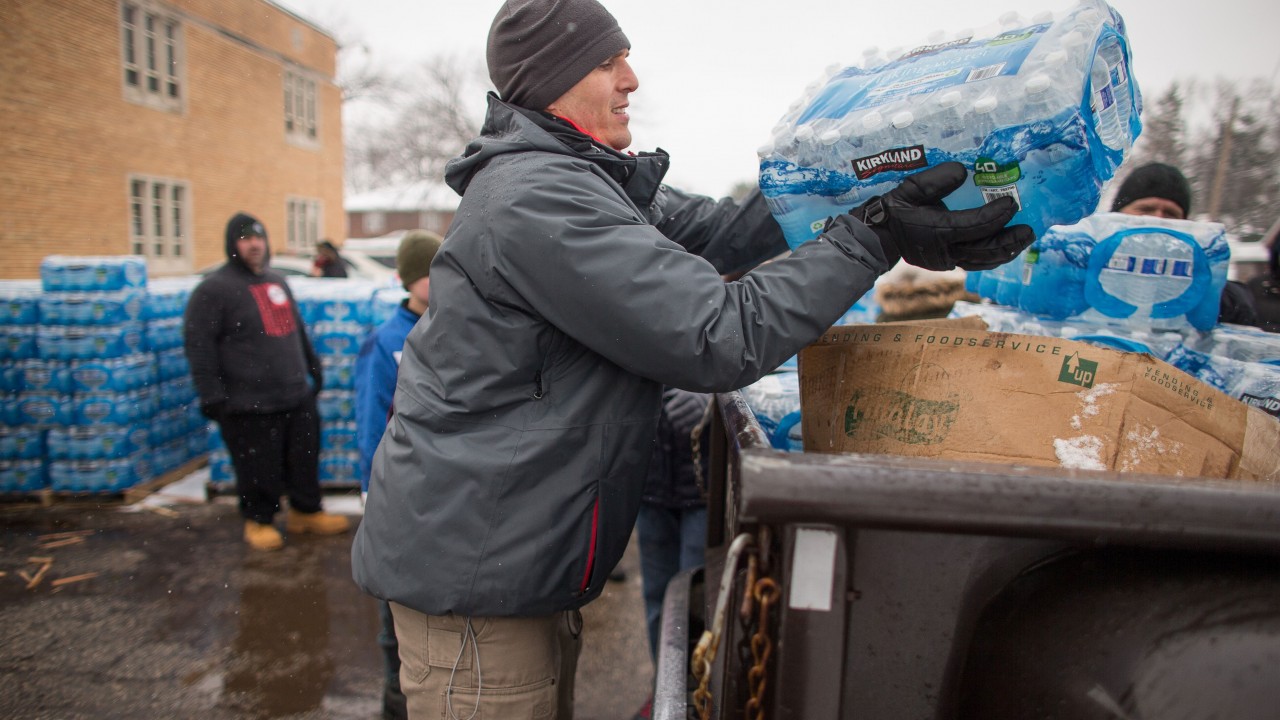
Volunteers load cases of free water a water distribution center in Flint, Michigan. (Photo: Geoff Robins/AFP/Getty Images)
EDITOR’S NOTE: As many experts have observed, this year’s presidential election could come down to a battle for votes Democrats used to take for granted.
Donald Trump is making an overt play for the so-called “Reagan Democrats,” blue collar voters whose defection three decades ago shook up the national political landscape and stoked the Reagan revolution. It’s no accident that Hillary Clinton’s first post-convention foray was into once reliably Democratic steel and coal country. Now, as then, the issues facing these voters are job and income security in a changing world. Only now, those concerns are being felt by far more than the steelworkers and their families whom Ronald Reagan wooed in 1980.
America’s deindustrialized heartland embodies one of the challenges reshaping the nation’s politics: The disappearance of the middle class and the growing gap between the haves and have-nots. That’s why BillMoyers.com is paying particular attention to these communities this year, focusing on their issues and giving voice to the people who live there. You can read more of our collection here.)
Today, President Barack Obama visits Flint, Michigan. To write about what he will be seeing in the town whose water was poisoned through government mismanagement and neglect, Moyers and Company turned to Curt Guyette, a reporter whose initially lonely investigations of the scandal was recognized in New York City on Tuesday by the Sidney Hillman Foundation.
Guyette’s role exposes the crisis not only in government but in the media: His groundbreaking work was supported not by a news organization, but by the American Civil Liberties Union of Michigan. The state ACLU’s executive director, Kary Moss, told a Common Cause conference in March that she took the unusual step of putting an investigative reporter on her staff because “given the state of journalism today I am not sure we can rely on established media.” For the people of Flint, her far-sightedness and Curt Guyette’s doggedness, paid off.
Finally.
If the crisis engulfing Flint, Michigan, had occurred in one tragic swoop, had the hard-bitten city been hit with a Superstorm Sandy or a Hurricane Katrina, the president of the United States would not have taken two years to come and personally inspect the damage. He would not have taken two years to hear directly from the victims about their needs, their losses.
But this was no act of nature wreaking mass destruction. Flint is a different kind of disaster – a totally avoidable, man-made catastrophe created by a state government hell-bent on imposing austerity at any cost.
Instead of fighting flood waters pouring through failed levies, the 100,000 residents of Flint have been slammed by a failed policy – the idea that government can be run like a business, with a ledger’s bottom line taking precedence above all else, including democracy.
As with nearly every other Michigan city and school district that’s seen the authority of duly elected local officials usurped by autocratic appointees of the governor, Flint has an African-American majority and a high poverty rate.
People who, in the eyes of the state, simply couldn’t afford access to something as essential as clean, safe drinking water.
Since the imposed switch to the Flint River was made in April 2014, the people of Flint have been exposed to E.coli scares, elevated levels of a cancer-causing chlorine byproduct, a deadly outbreak of Legionnaires’ disease and widespread lead contamination that’s caused unimaginable harm.
Along with this attack on their health, the people of Flint have had to endure the denigrating insult to their collective intelligence by officials who claimed with straight faces that the muck pouring from taps was completely safe.
Which is why President Obama will see that, in Flint, trust in government hasn’t just been shattered. Its shards have been ground to dust.
The switch to river water was supposed to have saved $5 million over a two-year period. Within 18 months, as the result of a relentless citizen-led effort to find and disclose the truth about the poison lurking in Flint’s water, the public health disaster became too great to ignore and Gov. Rick Snyder allowed the city to return to the Detroit water system that had been providing Flint with clean, safe water for 50 years.
That supposed $5 million in savings will be a rounding error when the tab for this disaster is finally tallied.
When considering the costs of the Flint water crisis, first and foremost comes the inescapable moral and legal obligation to provide every educational, medical, psychological and other wrap-around service needed to mitigate as much as possible the multiple harms done to Flint’s children by lead-contaminated water.
IQ loss, behavioral problems, learning disabilities and a school-to-prison pipeline waiting to swallow them up is a future faced by the lead-damaged children of Flint.
And it’s not just children suffering the health ill-effects of a powerful toxin that can cause high blood pressure, adrenal failure, memory loss, miscarriages and more.
Massive health care and education costs are just the beginning. From the replacement of corroded water pipes running beneath streets to appliances like hot water heaters and electric dishwashers that have been ruined, to the lost value of homes no one will buy, the full price to be paid for this disaster is staggering to calculate.
Beyond that is the human toll this horribly failed approach to governance has taken.
And that, above all else, is what President Obama needs to absorb during his visit to Flint. One thing he’s unlikely to absorb: The toxins that are still in the Flint water. Government officials claim it’s safe to drink if it has been filtered. But when asked if the president would be imbibing during his visit, White House Press Secretary Josh Earnest had this to say:
I’m not aware of any photo-ops that involve the President’s consumption of water. Based on what the EPA has communicated to the public, is that properly filtered water in Flint is safe to drink. So I certainly would encourage people to continue to listen to the advice that they get from our scientific and public health experts about what water is safe to drink, and the president will certainly follow that advice.
The president should be as skeptical of that expert advice as the people of Flint have learned to be. He needs to look into the faces of the people there and see the angst and anger and frustration and flat-out fatigue that have come from being poisoned and lied to and dismissed as inconsequential as they’ve been forced to live on plastic bottles of water for months on end.
And then he needs to do everything within his power to bring them the relief they need.
Immediately.




